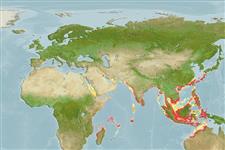Environment: milieu / climate zone / depth range / distribution range
Ökologie
seewasser demersal; standorttreu; tiefenbereich 0 - 60 m (Ref. 6205). Tropical; 34°N - 20°S, 35°E - 132°E (Ref. 6205)
Indo-Pacific: Singapore, Thailand, China, Hong Kong, Taiwan, Philippines, and southern Japan. Possibly distributed throughout the Indo-West Pacific from Delagoa Bay, South Africa to Okinawajima, Japan but not recorded from Australia or southern New Guinea. Very similar to Sillago burrus.
Length at first maturity / Size / Gewicht / Alter
Maturity: Lm 12.0 range ? - ? cm
Max length : 30.0 cm SL Männchen/unbestimmt; (Ref. 6205)
Rückenflossenstacheln (insgesamt) : 12; Rückenflossenweichstrahlen (insgesamt) : 18 - 20; Afterflossenstacheln: 2; Afterflossenweichstrahlen: 17 - 19; Wirbelzahl: 34. Swim bladder with three rudimentary anterolateral extensions instead of four; differs from S. maculata in lacking well developed anterolateral extensions reaching to level of vent. Body color is silvery with scattered dark brown elongate blotches on the sides.
Occur in inshore coastal waters, commonly in embayments on silty bottoms (Ref. 9679). Juveniles have been known to burrow in the sand (Ref. 6208). Oviparous (Ref. 205), multiple spawner (Ref. 56320). Small local fisheries exist throughout the range of the species. The flesh is prone to spoil rapidly and the Oriental sillago is not considered as highly as the inshore sillaginids (Ref. 6205). S. aeolus has not been found in association with S. burrus or S. maculata.
McKay, R.J., 1992. FAO Species Catalogue. Vol. 14. Sillaginid fishes of the world (family Sillaginidae). An annotated and illustrated catalogue of the sillago, smelt or Indo-Pacific whiting species known to date. Rome: FAO. FAO Fish. Synop. 125(14):87p. (Ref. 6205)
IUCN Rote Liste Status (Ref. 130435)
Bedrohung für Menschen
Harmless
Nutzung durch Menschen
Fischereien: weniger kommerziell
Tools
Zusatzinformationen
Download XML
Internet Quellen
Estimates based on models
Preferred temperature (Ref.
123201): 25.2 - 29.1, mean 28.5 °C (based on 1092 cells).
Phylogenetic diversity index (Ref.
82804): PD
50 = 0.5000 [Uniqueness, from 0.5 = low to 2.0 = high].
Bayesian length-weight: a=0.00617 (0.00362 - 0.01050), b=3.05 (2.90 - 3.20), in cm total length, based on LWR estimates for this species & Genus-body shape (Ref.
93245).
Trophic level (Ref.
69278): 3.3 ±0.4 se; based on size and trophs of closest relatives
Widerstandsfähigkeit (Ref.
120179): hoch, Verdopplung der Population dauert weniger als 15 Monate. (Fec = 11,131).
Fishing Vulnerability (Ref.
59153): Low to moderate vulnerability (27 of 100).
